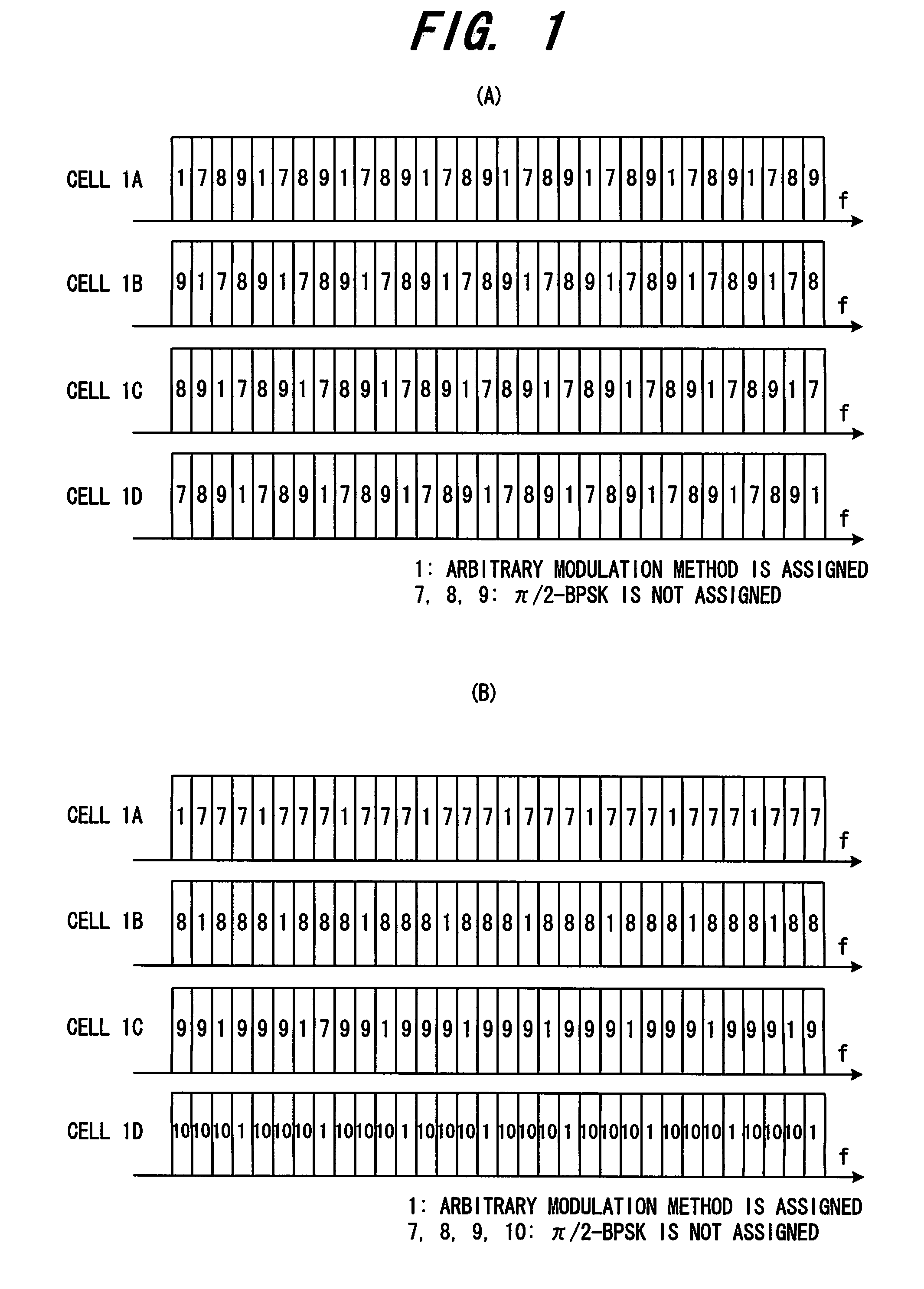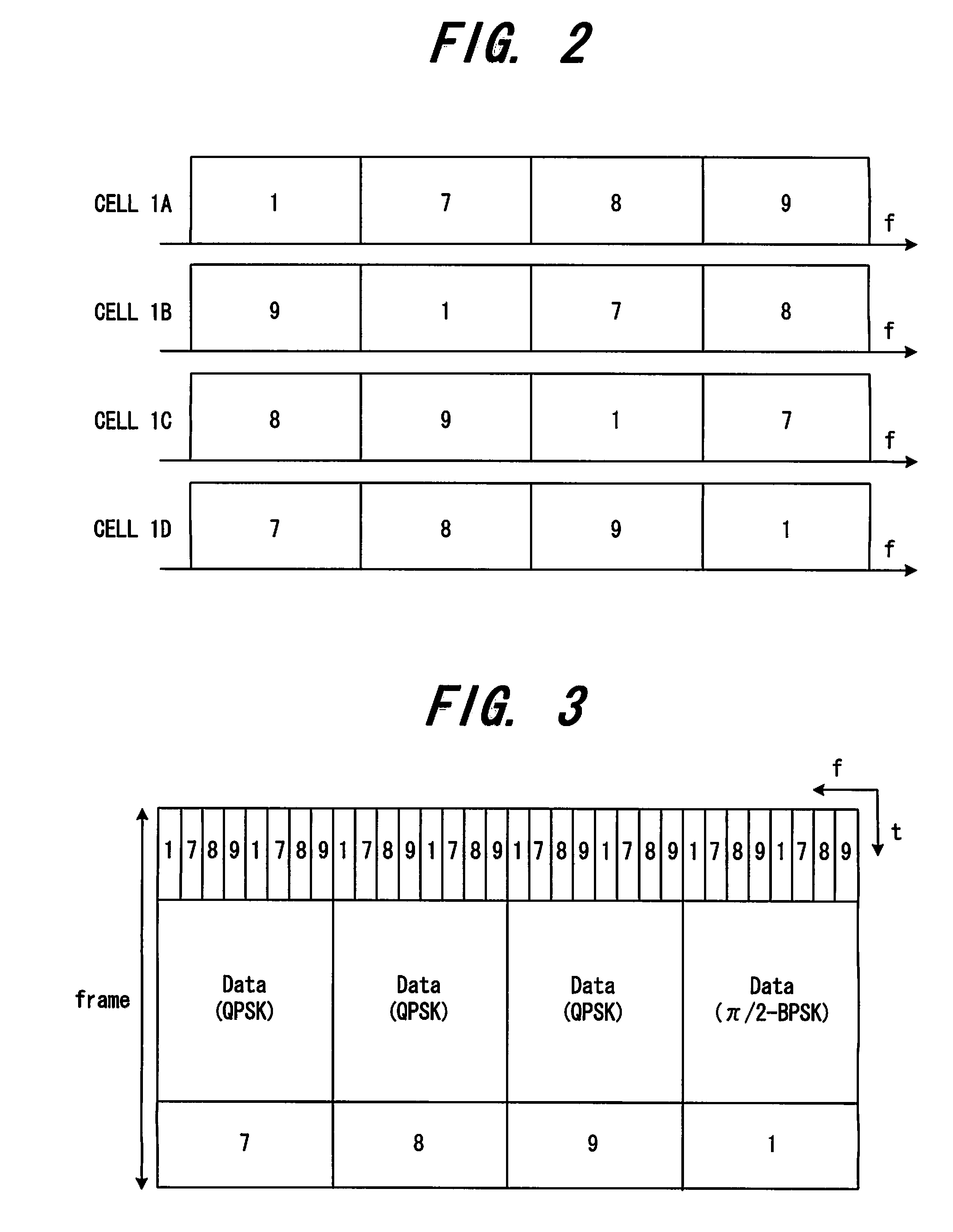Base Station And Method Of Assigning Frequencies To Pilot Sequences
a pilot sequence and frequency technology, applied in frequency-division multiplex, transmission monitoring, wireless commuication services, etc., can solve the problems of poor average power added efficiency, transmission efficiency deterioration, distortion, etc., to increase the number of pilot sequences, improve channel estimation accuracy, and increase cell repletion number
- Summary
- Abstract
- Description
- Claims
- Application Information
AI Technical Summary
Benefits of technology
Problems solved by technology
Method used
Image
Examples
first embodiment
(A) First Embodiment
(a) Method of Assigning Frequencies to Pilot Sequences
[0087]FIG. 1 to FIG. 3 are explanatory drawings of methods for assigning frequencies to each of the pilot sequences of a first embodiment of the invention, where the horizontal axis is the frequency and the numerical values are the pilot sequence numbers. In the examples shown in FIG. 1 to FIG. 3 four adjacent cells 1A, 1B, 1C and 1D can use the pilot sequences 1, 7, 8 and 9 (see FIG. 33). For pilot sequence 1, the CM is less than π / 2-BPSK, so pilot sequence 1 can be used in an arbitrary modulation method, and for pilot sequences 7, 8 and 9, the CM is larger than π / 2-BPSK but less than QPSK, so they can be used for modulation methods other than π / 2-BPSK. Each of the embodiments of the present invention is not limited to cells and can also be applied to sectors, however, in the explanation below, only the case of applying the invention to cells will be explained.
[0088]In the present invention, in order to incre...
second embodiment
(B) Second Embodiment
[0117]There are two purposes that pilots are used for; channel estimation and SIR measurement for adaptive modulation scheduling. Pilots for channel estimation only need the same frequency band as data, however, in order for accurate channel estimation, high quality is desired. On the other hand, pilots for SIR measurement require a wide bandwidth in order to perform frequency scheduling, however, there is not as much a need for quality as in the case of channel estimation. Therefore, by separating and transmitting pilots according to usage it is possible to improve transmission efficiency of the pilots.
[0118]FIG. 13 is an explanatory drawing of a method for assigning frequencies to pilots for channel estimation and for pilots for SIR measurement, where the horizontal axis is the frequency. In the figure, CE0 to CE3 are pilot sequences for channel estimation, and CQ0 to CQ5 are pilot sequences for SIR measurement. A narrow band of frequencies F0 to F3 is assigne...
third embodiment
(C) Third Embodiment
[0129]Interference between cells also occurs between pilot signals having different sequence numbers. This interference is not as big as the interference between pilot signals having the same sequence number, however, for users near the end of a cell (cell boundary) it is something that cannot be ignored. Therefore, for users at the cell ends it is necessary that the pilot frequencies of adjacent cells do not overlap.
[0130]FIG. 16 is an example of assigning frequencies to pilots of a third embodiment of the invention, where the horizontal axis is the frequency. In the example of FIG. 16, pilot frequencies are such that they do not overlap at the boundary between adjacent cells (cell ends). The pilots at the cell ends of each of the cells 1A to 1D can be of a different sequence, however, in the figure, a pilot sequence having sequence number 1 is used, and the frequencies that are assigned to that sequence are different for each cell. In addition, pilot sequences ...
PUM
 Login to View More
Login to View More Abstract
Description
Claims
Application Information
 Login to View More
Login to View More - R&D
- Intellectual Property
- Life Sciences
- Materials
- Tech Scout
- Unparalleled Data Quality
- Higher Quality Content
- 60% Fewer Hallucinations
Browse by: Latest US Patents, China's latest patents, Technical Efficacy Thesaurus, Application Domain, Technology Topic, Popular Technical Reports.
© 2025 PatSnap. All rights reserved.Legal|Privacy policy|Modern Slavery Act Transparency Statement|Sitemap|About US| Contact US: help@patsnap.com



